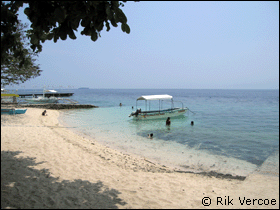Country Philippines Founded 6 February 1852 Demonym(s) Moalboalanon Local time Wednesday 11:29 AM | District 2nd district of Cebu Barangay Area 124.9 km² Province Cebu | |
 | ||
Region Central Visayas (Region VII) Weather 28°C, Wind N at 13 km/h, 82% Humidity Points of interest Pescador Island, Love's Beach & Dive Res, Kasai Village Beach Re, Sampaguita Resort, Savedra Beach Resort | ||
Moalboal is a 4th municipal income class municipality in the province of Cebu, Philippines. According to the 2015 census, it has a population of 31,130. In the 2016 electoral roll, it had 19,821 registered voters.
Contents
Map of Moalboal, Cebu, Philippines
Extending as a peninsula on the south-western tip of Cebu, Moalboal is bordered to the west by the Tañon Strait. Negros Island can be seen from the western shoreline. Moalboal is between the towns of Alcantara and Badian, located 89 kilometres (55 mi) from Cebu City, about 2½ hours by bus.
Pescador Island, a popular tourist attraction, is part of the municipality.
Barangays
Moalboal comprises 15 barangays:
Demographics
In the 2016 electoral roll, it had 19,821 registered voters, meaning that 64% of the population are aged 18 and over.
Though the majority of the people in Moalboal are Cebuanos, a few members of cultural minorities have found their way there. Bajaus who are similar to Muslim nomads, are often seen in the streets, especially during the holiday season, as some of them make their living by begging. There is no evidence though that the badjaos have taken up permanent residence in the town.
Industry and trade
Moalboal is a peninsula and therefore it is almost entirely surrounded by water. Majority of the people who live in the flat lands engage in fishing as their main mode of livelihood. Those who live in the mountain regions, like Agbalanga and Bala, live through farming.
The common mode of transportation is by motorcycles with side cars, known locally as pedicabs or, depending on the distance, tricycles with side cars, called trisikads.
Tourism
Since the 1970s, Moalboal has developed a tourism industry based on recreational diving and beaches. Panagsama Beach is where most resorts and restaurants are established. Further north on the peninsula, in Saavedra, is White Beach (Basdako), a 2 kilometres (1.2 mi) beach which still has sand. This beach used to be quieter and mostly frequented by locals, but has only recently developed a tourist trade.
In Moalboal most tourists stay at either Panagsama Beach (Basdiot) or White Beach (Basdako), known for its beautiful sandy beach both located 3–5 kilometres (1.9–3.1 mi) away from the bus stop in Moalboal. It is easy to find transportation from the bus stop to either beach.
There is plenty of accommodation near either beach, although Panagsama has the most bars, restaurants, people and dive shops. Since the resorts in the area cater mostly to divers, entertainment is laid back and more of a chilled out pub style atmosphere.
Recreational diving is the main tourist activity in Moalboal, and is considered very good, even according to Philippine standards. The reefs along the west coast of the Copton peninsula are home to a great variety of marine life. Pescador Island, about 3 kilometres (1.9 mi) off the coast, is the most popular dive spot. The structure of the reef that follows the entire coast line has made the place ideal for scuba-diving, snorkeling and freediving. Divers can enjoy easy access to the reef since the drop off is shallow and close to shore but drops down to more than 40 metres (130 ft). Big turtles can sometimes be seen very close to the shore line.
Other popular tourist attractions such as waterfalls, caves and canyons are found within 20 kilometres (12 mi) of Moalboal.
Fiesta
The annual feast of Moalboal is held on the 15 and 16 of May. Moalboal is known also for its "Kagasangan Festival" (coral) in which they perform tribal dances and music.
